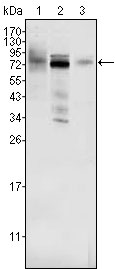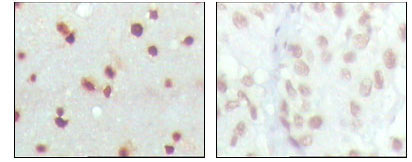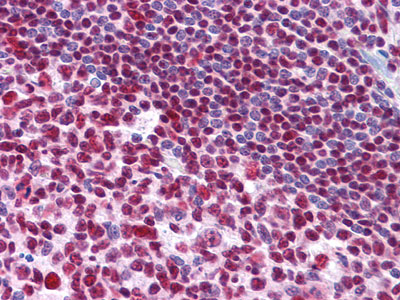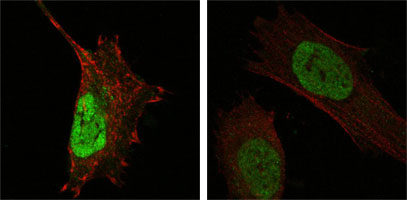MDM4 Antibody
Purified Mouse Monoclonal Antibody
- SPECIFICATION
- CITATIONS
- PROTOCOLS
- BACKGROUND

Application
| WB, IHC, ICC, E |
|---|---|
| Primary Accession | O15151 |
| Reactivity | Human |
| Host | Mouse |
| Clonality | Monoclonal |
| Clone Names | 2D10F4 |
| Isotype | IgG1 |
| Calculated MW | 55kDa |
| Description | MDM4, encodes a 490-amino acid protein containing a RING finger domain and a putative nuclear localization signal. The MDM4 putative nuclear localization signal, which all Mdm proteins contain, is located in the C-terminal region of the protein. The mRNA is expressed at a high level in thymus and at lower levels in all other tissues tested. MDM4 protein produced by in vitro translation interacts with p53 via a binding domain located in the N-terminal region of the MDM4 protein. MDM4 shows significant structural similarity to p53-binding protein MDM2. |
| Immunogen | Purified recombinant fragment of human MDM4 expressed in E. Coli. |
| Formulation | Ascitic fluid containing 0.03% sodium azide. |
| Gene ID | 4194 |
|---|---|
| Other Names | Protein Mdm4, Double minute 4 protein, Mdm2-like p53-binding protein, Protein Mdmx, p53-binding protein Mdm4, MDM4, MDMX |
| Dilution | WB~~1/500 - 1/2000 IHC~~1/500 - 1/2000 ICC~~N/A E~~N/A |
| Storage | Maintain refrigerated at 2-8°C for up to 6 months. For long term storage store at -20°C in small aliquots to prevent freeze-thaw cycles. |
| Precautions | MDM4 Antibody is for research use only and not for use in diagnostic or therapeutic procedures. |
| Name | MDM4 |
|---|---|
| Synonyms | MDMX |
| Function | Along with MDM2, contributes to TP53 regulation (PubMed:32300648). Inhibits p53/TP53- and TP73/p73-mediated cell cycle arrest and apoptosis by binding its transcriptional activation domain. Inhibits degradation of MDM2. Can reverse MDM2-targeted degradation of TP53 while maintaining suppression of TP53 transactivation and apoptotic functions. |
| Cellular Location | Nucleus. |
| Tissue Location | Expressed in all tissues tested with high levels in thymus |

Thousands of laboratories across the world have published research that depended on the performance of antibodies from Abcepta to advance their research. Check out links to articles that cite our products in major peer-reviewed journals, organized by research category.
info@abcepta.com, and receive a free "I Love Antibodies" mug.
Provided below are standard protocols that you may find useful for product applications.
References
1. Proc Natl Acad Sci U S A. 2002 Dec 24;99(26):16899-903. 2. Cell Cycle. 2004 Apr;3(4):472-8. 3. Biochem Biophys Res Commun. 2005 Jul 8;332(3):702-9.
If you have used an Abcepta product and would like to share how it has performed, please click on the "Submit Review" button and provide the requested information. Our staff will examine and post your review and contact you if needed.
If you have any additional inquiries please email technical services at tech@abcepta.com.













 Foundational characteristics of cancer include proliferation, angiogenesis, migration, evasion of apoptosis, and cellular immortality. Find key markers for these cellular processes and antibodies to detect them.
Foundational characteristics of cancer include proliferation, angiogenesis, migration, evasion of apoptosis, and cellular immortality. Find key markers for these cellular processes and antibodies to detect them. The SUMOplot™ Analysis Program predicts and scores sumoylation sites in your protein. SUMOylation is a post-translational modification involved in various cellular processes, such as nuclear-cytosolic transport, transcriptional regulation, apoptosis, protein stability, response to stress, and progression through the cell cycle.
The SUMOplot™ Analysis Program predicts and scores sumoylation sites in your protein. SUMOylation is a post-translational modification involved in various cellular processes, such as nuclear-cytosolic transport, transcriptional regulation, apoptosis, protein stability, response to stress, and progression through the cell cycle. The Autophagy Receptor Motif Plotter predicts and scores autophagy receptor binding sites in your protein. Identifying proteins connected to this pathway is critical to understanding the role of autophagy in physiological as well as pathological processes such as development, differentiation, neurodegenerative diseases, stress, infection, and cancer.
The Autophagy Receptor Motif Plotter predicts and scores autophagy receptor binding sites in your protein. Identifying proteins connected to this pathway is critical to understanding the role of autophagy in physiological as well as pathological processes such as development, differentiation, neurodegenerative diseases, stress, infection, and cancer.





